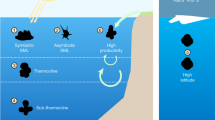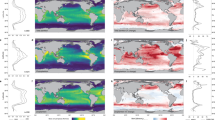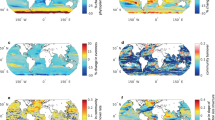Abstract
Understanding the variability of marine biodiversity is a central issue in microbiology. Current observational programs are based on in situ studies, but their implementation at the global scale is particularly challenging, owing to the ocean extent, its temporal variability and the heterogeneity of the data sources on which compilations are built. Here, we explore the possibility of identifying phytoplanktonic biodiversity hotspots from satellite. We define a Shannon entropy index based on patchiness in ocean color bio-optical anomalies. This index provides a high resolution (1 degree) global coverage. It shows a relation to temperature and mid-latitude maxima in accordance with those previously evidenced in microbiological biodiversity model and observational studies. Regional maxima are in remarkable agreement with several known biodiversity hotspots for plankton organisms and even for higher levels of the marine trophic chain, as well as with some in situ planktonic biodiversity estimates (from Atlantic Meridional Transect cruise). These results encourage to explore marine biodiversity with a coordinated effort of the molecular, ecological and remote sensing communities.
Similar content being viewed by others
Log in or create a free account to read this content
Gain free access to this article, as well as selected content from this journal and more on nature.com
or
References
Alvain S, Moulin C, Dandonneau Y, Loisel H . (2008). Seasonal distribution and succession of dominant phytoplankton groups in the global ocean: a satellite view. Global Biogeochem Cy 22: GB3001.
Barton AD, Dutkiewicz S, Flierl G, Bragg J, Follows MJ . (2010). Patterns of diversity in marine phytoplankton. Science 327: 1509–1511.
Block BA, Jonsen ID, Jorgensen SJ, Winship AJ, Shaffer SA, Bograd SJ et al. (2011). Tracking apex marine predator movements in a dynamic ocean. Nature 475: 86–90.
Cermeño P, Marañón E, Harbour D, Figueiras GF, Crespo GB, Huete-Ortega M et al. (2008). Resource levels, allometric scaling of population abundance, and marine phytoplankton diversity. Limnol Oceanogr 53: 312–318.
d′Ovidio F, De Monte S, Alvain S, Dandonneau Y, Lévy M . (2010). Fluid dynamical niches of phytoplankton types. PNAS 107: 18366–18370.
Hillebrandt H . (2004). On the generality of the latitudinal diversity gradient. Am Nat 163: 192–211.
Irigoien X, Huisman J, Harris RP . (2004). Global biodiversity patterns of marine phytoplankton and zooplankton. Nature 429: 863–867.
Jones SE . (2007). The marine microbial world: a voyage of discovery. ISME J 1: 469–470.
Karsenti E, Acinas SG, Bork P, Bowler C, De Vargas C, Raes J et al. (2011). A holistic approach to marine eco-systems biology. PLoS Biol 9: e1001177.
Kaschner K, Tittensor DP, Ready J, Gerrodette T, Worm B . (2011). Current and future patterns of global marine mammal biodiversity. PLoS ONE 6: e19653.
Levin S . (1992). The problem of scale in biology. Ecology 73: 1943–1967.
Raes J, Letunic I, Yamada T, Jensen LJ, Bork P . (2011). Toward molecular trait-based ecology through integration of biogeochemical, geographical and metagenomic data. Mol Syst Biol 7: 473.
Rusch DB, Halpern AL, Sutton G, Heidelberg KB, Williamson S, Yooseph S et al. (2007). The Sorcerer II global ocean sampling expedition: Northwest Atlantic through Eastern Tropical Pacific. PLoS Biol 5: e77.
Rutherford S, D'Hondt S, Prell W . (1999). Environmental controls on the geographic distribution of zooplankton diversity. Nature 400: 749–753.
Stegen JC, Ferriere R, Enquist BJ . (2012). Evolving ecological networks and the emergence of biodiversity patterns across temperature gradients. Proc R Soc B 279: 1051–1060.
Tittensor DP, Mora C, Jetz W, Lotze HK, Ricard D, Berghe EV et al. (2010). Global patterns and predictors of marine biodiversity across taxa. Nature 466: 1098–1101.
Worm B, Sandow M, Oschlies A, Lotze HK, Myers RA . (2005). Global patterns of predator diversity in the open oceans. Science 309: 1365–1369.
Zinger L, Amaral-Zettler LA, Fuhrman JA, Horner-Devine MC, Huse SM, DBM Welch et al. (2011). Global patterns of bacterial beta-diversity in seafloor and seawater ecosystems. PLoS One 6: e24570.
Acknowledgements
We thank NASA and the GLOBCOULOUR project for access to ocean color data and AMSR-E SST data. This study uses data from the Atlantic Meridional Transect consortium (NER/0/5/2001/000680) provided by the British Oceanographic Data Centre, and supported by the Natural Environment Research Council. SDM was supported by the ANR blanc program Phytback and by the EU 7FP MicroB3. AS is supported by the EMERGENCE EME111 UPMC project. This work is a contribution to the OSTST ALTIMECO project.
Author information
Authors and Affiliations
Corresponding author
Ethics declarations
Competing interests
The authors declare no conflict of interest.
Additional information
Supplementary Information accompanies this paper on The ISME Journal website
Supplementary information
Rights and permissions
About this article
Cite this article
De Monte, S., Soccodato, A., Alvain, S. et al. Can we detect oceanic biodiversity hotspots from space?. ISME J 7, 2054–2056 (2013). https://doi.org/10.1038/ismej.2013.72
Received:
Revised:
Accepted:
Published:
Issue date:
DOI: https://doi.org/10.1038/ismej.2013.72
Keywords
This article is cited by
-
Basin-scale biogeochemical and ecological impacts of islands in the tropical Pacific Ocean
Nature Geoscience (2022)
-
Fine-scale structures as spots of increased fish concentration in the open ocean
Scientific Reports (2021)
-
Contrasting biogeography and diversity patterns between diatoms and haptophytes in the central Pacific Ocean
Scientific Reports (2018)
-
The role of submesoscale currents in structuring marine ecosystems
Nature Communications (2018)
-
Stratifying ocean sampling globally and with depth to account for environmental variability
Scientific Reports (2018)



